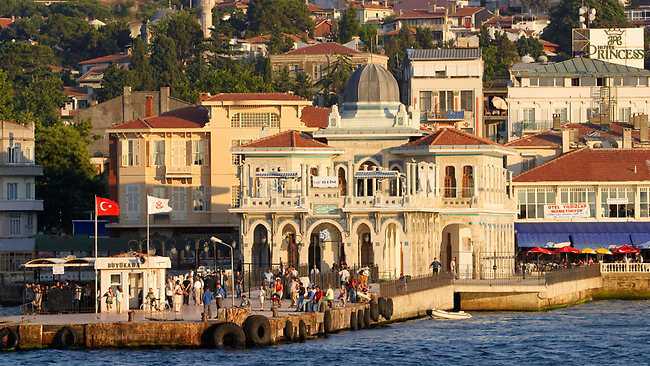
Buyukada, the largest of the Princes’ Islands, an archipelago in the Sea of Marmara. Picture: Alamy Source: Supplied
YOU have done the sights – the Hagia Sofia and the great imperial mosques, the Topkapi Palace and the Grand Bazaar, the Bosphorus cruise and Basilica Cistern. With the tourist boxes ticked and the past squared away, it’s time to start exploring the real, living city.
You may have had enough of museums, but Orhan Pamuk’s new Museum of Innocence in the bohemian neighbourhood of Cihangir is worth a visit, if only for the abiding oddness of the concept as much as anything in the exhibits. The museum and Pamuk’s eponymous novel were conceived at the same time, and as Turkey’s Nobel Prize-winning author wrote the book about love and obsession set in 1970s Istanbul, he also collected artefacts.
The result is a charming confection of the paraphernalia of bourgeois Turkish life, from a collection of cigarette butts supposedly smoked by the novel’s heroine to toys, cinema posters and Victorian-era family photos. It is a monument to whimsy, a great literary project and a vanished era all at the same time.
Digital Pass $1 for first 28 Days
Istanbul is one of the gourmet capitals of the world, but you have to dig a little to find its most interesting vernacular food. To really get to grips with the authentic tastes of the city, spend a half hour or so browsing istanbuleats.com – a site and, for the old-fashioned, a book compiled by passionate connoisseurs of Istanbul’s waterside fish-grilling joints, its raucous raki-and-mezze restaurants (known as meyhanes) and its endless varieties of street food.
You can trace the social history of the city through its restaurants, or take a gastronomic tour of the rest of Turkey and even the old empire, with its Balkan, Middle Eastern and Caucasian influences. Anatolian soul food restaurant Ciya is definitely worth a trip to the Asian side of the city, while the newish bread-and-stew restaurant Datli Maya is as brilliant and tiny as its owner, culinary wizard Dilara Erbay.
Those committed to exploring Istanbul’s gastronomic underbelly can even find directions to a famous pair of rival sheep’s-head restaurants located on opposite corners of a crossroads. One sells the heads boiled, the other roasted (counterintuitively, boiled is better).
Of an evening, don’t get stuck in the Old City, which is a ghetto of touristy restaurants and pushy carpet pedlars. Istanbul’s real life is elsewhere, in the mile-long strip of pedestrianised streets around the old Grande Rue de Pera, the heart of the European quarter now known as Beyoglu.
Start at the House Cafe by the Tunel funicular and work your way down Istiklal Avenue though backstreets crowded with tables and revellers. One can go high-low, literally and metaphorically, from flashy socialite-packed rooftop bars such as 360 to grungy live music venues such as Haymatlos, concealed in a crumbling Ottoman office building.
A full tour of all the hidden bars and restaurants would take about eight years. At 2am you’ll find Istiklal Avenue still packed from end to end, a sight that beats even Barcelona’s La Rambla into a cocked hat.
After a heavy night in the city you may wish to escape to the Princes’ Islands, an archipelago in the Sea of Marmara where the Byzantines exiled their surplus royals and the Levantine bourgeoisie of the late 19th century built large wooden summer villas. But one has to be smart about planning a visit, because on hot summer days they are also the equivalent of New York’s Coney Island – a place where every local who can’t afford to go anywhere else crowds on to packed ferries.
If you’re rich, take a 10-person sea taxi from central Istanbul. Or take the public ferry from Kabatas, but on a weekday. On Buyukada, the largest of the islands, avoid the rip-off tourist restaurants on the seaside strip and hike (or bike) up the mountain to the monastery of Aya Yorgi, with its charming open-air restaurant and breathtaking views of the whole giant city of 15 million souls, now spread at your feet, distant and silent.
The Spectator
via Insider’s Istanbul | The Australian.

Leave a Reply